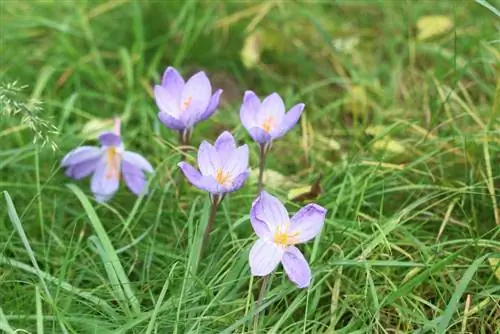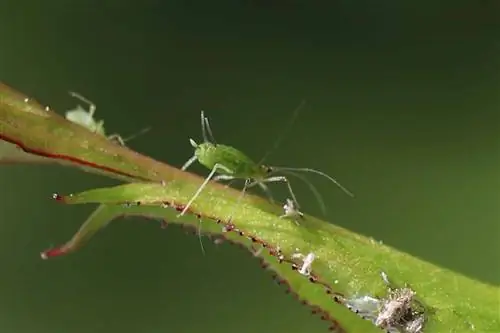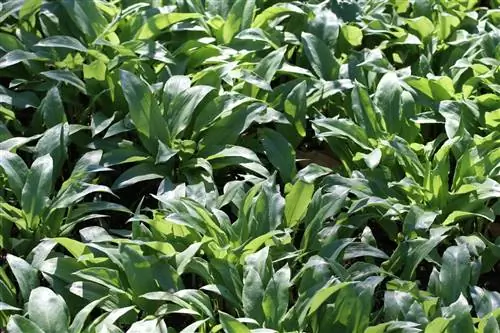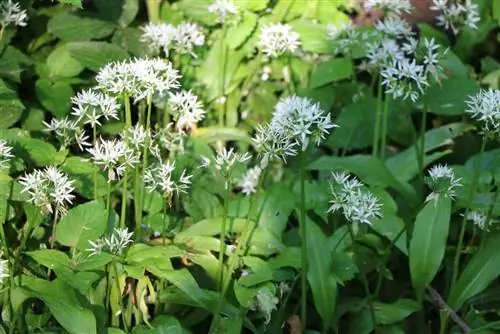- Author admin [email protected].
- Public 2023-12-17 03:39.
- Last modified 2025-01-24 12:45.
Autumn crocuses are classified as perennial plants, meaning they live for several years and bloom several times during this time frame. It reaches heights of between 8 cm and 30 cm and, thanks to its survival strategy, can survive even in difficult climatic conditions. The important plant parts of the autumn crocus are underground. At this time of year, the old sprout tuber is broken down and a fresh tuber, needed for sprouting next spring, is developed over it. A new side shoot also grows into a tuber. From spring onwards, long and narrow leaves form, which later protect the flowers and can be up to 40 cm long in total.
Special features of the autumn crocuses
Three flowers adorn the autumn crocus, which are between the colors pale pink and violet. Sometimes white flowers are also formed. The autumn crocus blooms between September and October, and in some cases also in spring depending on the location. Pollination is carried out by insects. Once the capsule fruit and seeds have formed, they are either spread by ants or scattered into the surrounding area by the wind. Tip: the flowers are similar to the crocus or autumn crocus.
Area of distribution of autumn crocuses
Autumn crocuses need a moist and nutrient-rich soil as a location. They like to grow in sun or partial shade and thrive best protected from the wind. These can be meadows, but also embankments. The locations lie between southern Ireland, Scandinavia and Central Europe to northern Italy to the east and western Ukraine.
Poisonousness of autumn crocuses
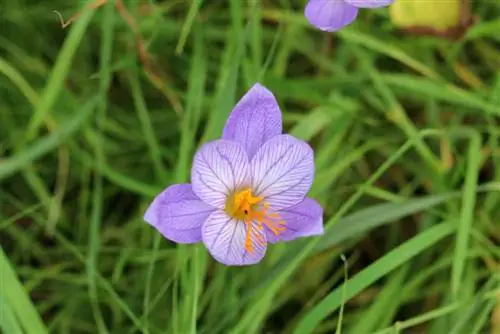
The autumn crocus is a plant that - like few others - never shows its leaves and flowers together: Either the leaves can be seen in spring, then the flowering has already passed, or in autumn the flowers, then they are Leaves no longer there. This makes it difficult for the viewer to identify it and it is quickly confused with wild garlic (Allium ursinum). This also has elongated and fresh green leaves like the autumn crocus. However, wild garlic could be recognized by its garlic smell if you tear the leaves and the smell is released. On the other hand, it is confused with lily of the valley (Convallaria majalis), which can be just as disastrous because they are just as poisonous as the autumn crocus.
The flower of the autumn crocus is the most poisonous part of the plant, which mainly contains the poison cholchicine. However, seeds, tubers and leaves still contain so many toxic substances that it would be enough to cause poisoning. Even small amounts of poison, such as those left on your fingers when picking, can be enough to kill a person. Children who accidentally come into contact with the plant are particularly affected. Particular caution should therefore be exercised when harvesting hay. Of course it is also poisonous to animals, both small and large.
Autumn crocus in the garden
Despite all the toxicity and caution, the autumn crocus can also be planted in the home garden. Here it is often used as a splash of color for autumn, because there is not much in bloom anymore, especially at this time of year. Another option would be to simply place the autumn crocus bulbs on the windowsill and admire the many flowers that seemingly bloom out of nowhere. The tuber can then be planted in the garden. They bloom again every autumn and do not require any special care. As soon as children live in the house or come to visit, the tubers should be removed to avoid poisoning accidents.
Tip:
Do not plant in gardens where children play.
Conclusion
The autumn crocus is a flowering plant that, similar to the crocus, shows its flowers in different shades of pink to purple. It will never show the flowers and leaves at the same time, by the time it blooms the leaves have already withered. Because they bloom in autumn as if it were spring, they got their name autumn crocus. Unfortunately, the plant is highly poisonous in all parts, which is why it cannot be found in many gardens. The fact that they exist in nature can already be a problem, and their beautiful appearance is of no use. If it grows in meadows, it gets into the livestock feed during hay harvest and may even be touched by people. But the poison of the autumn crocus can also reach humans through the milk of farm animals if they eat the plant parts with their green fodder.
What you should know about the autumn crocus in brief
- A highly poisonous plant that is poisonous to all parts of the plant.
- It reproduces itself.
- In Germany it is most widespread in western and southern Germany.
- The autumn crocus produces leaves in spring and flowers in autumn.
- It looks like a crocus plant.
- It blooms from light pink to dark purple, rarely in white.
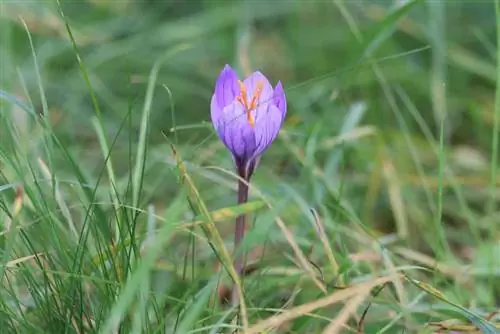
The special thing about the autumn crocus is its life cycle. The fruit ripens in summer, before flowering. The plant, which resembles a crocus, blooms from the end of August until October and sometimes even longer. The autumn crocus is poisonous. An anti-inflammatory and cell division-inhibiting substance is obtained from seeds, flowers and tubers that helps against gout, rheumatism, nerve pain, leukemia, tumors and some other diseases.
- The autumn crocus prefers a sunny location.
- She loves nutrient-rich, moist, calcareous soil.
- It thrives well in meadows and on embankments.
- She likes it warm and protected from the wind.
- In an ideal location, the plant spreads massively.
The autumn crocus is a bulbous plant. Cultivation is incredibly easy. You simply stick the onion into the ground, ideally 5 to 10 cm deep. Propagation via seeds is also possible, but takes up to 18 months. At best, the temperature must remain constant at 15 degrees Celsius. The best time to plant autumn crocuses is July and August. The planting distance should be approx. 10 to 25 cm. The plants like to grow in front of bushes and under deciduous trees. Newly purchased tubers can simply be placed on a windowsill before planting. Even without soil or watering, they produce up to 12 flowers per bulb. After flowering they are then transplanted. Be careful, don't forget, the plant is poisonous, be careful with children! Even as an adult, you should only touch the plant with gardening gloves and wash your hands immediately afterwards.

